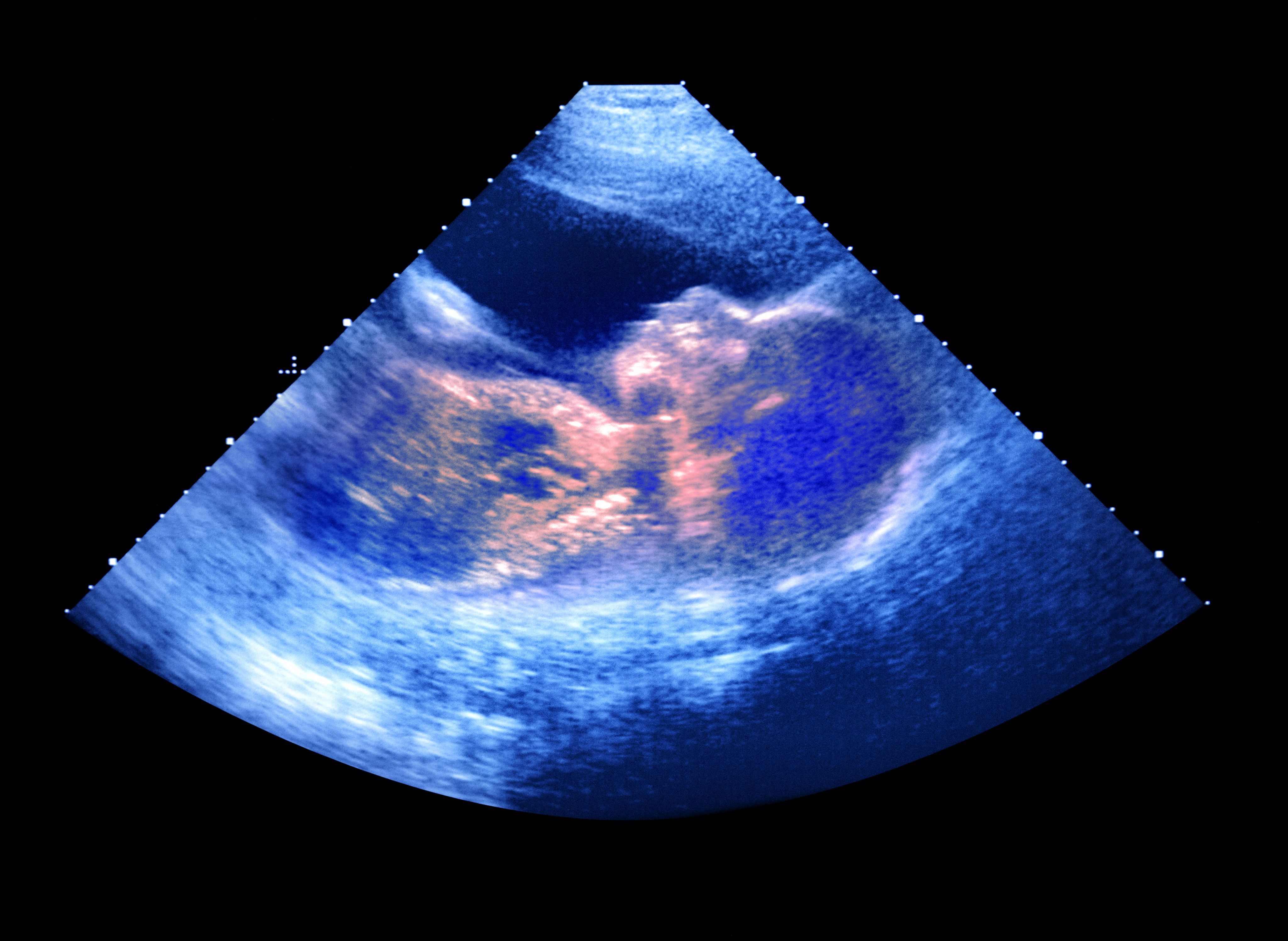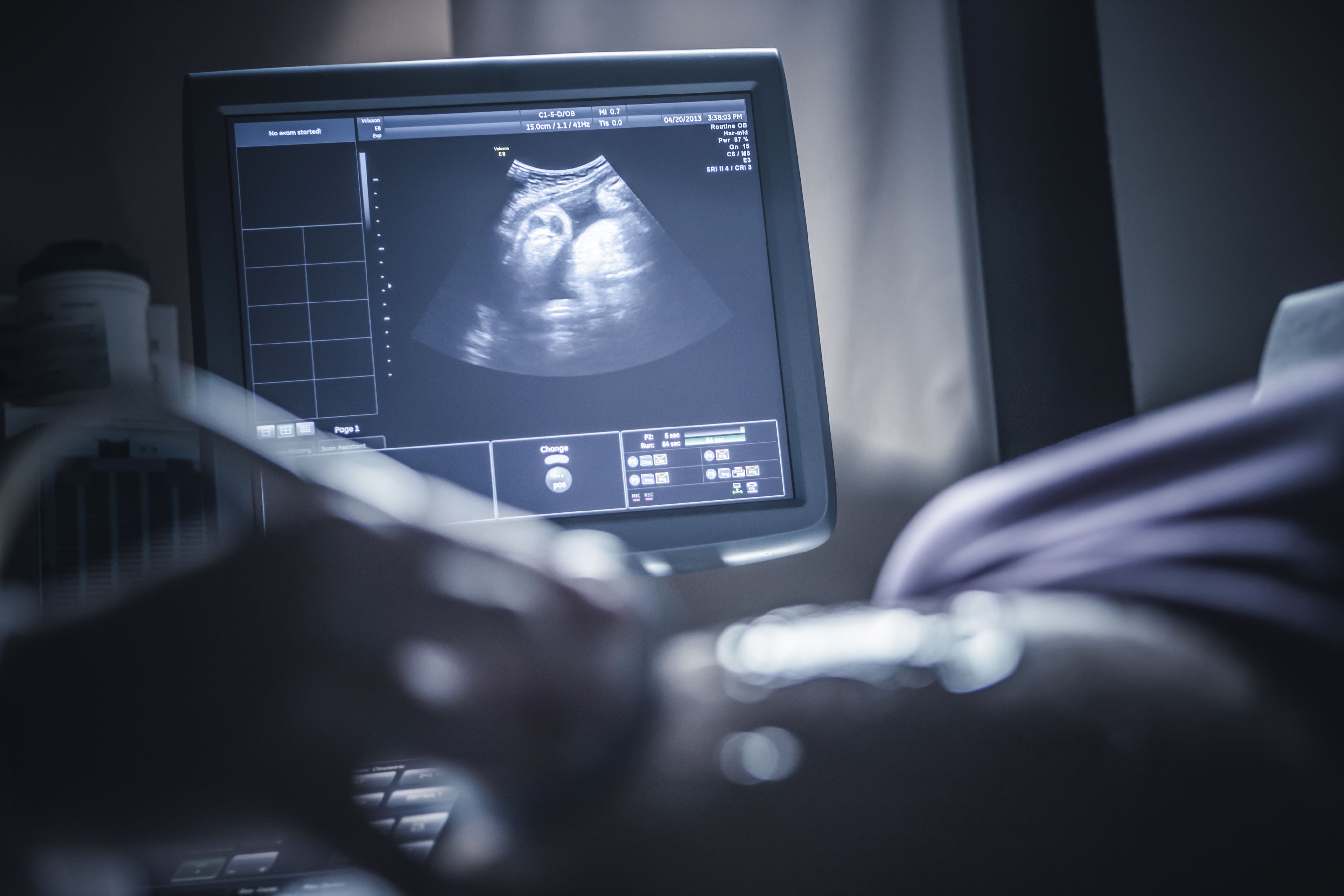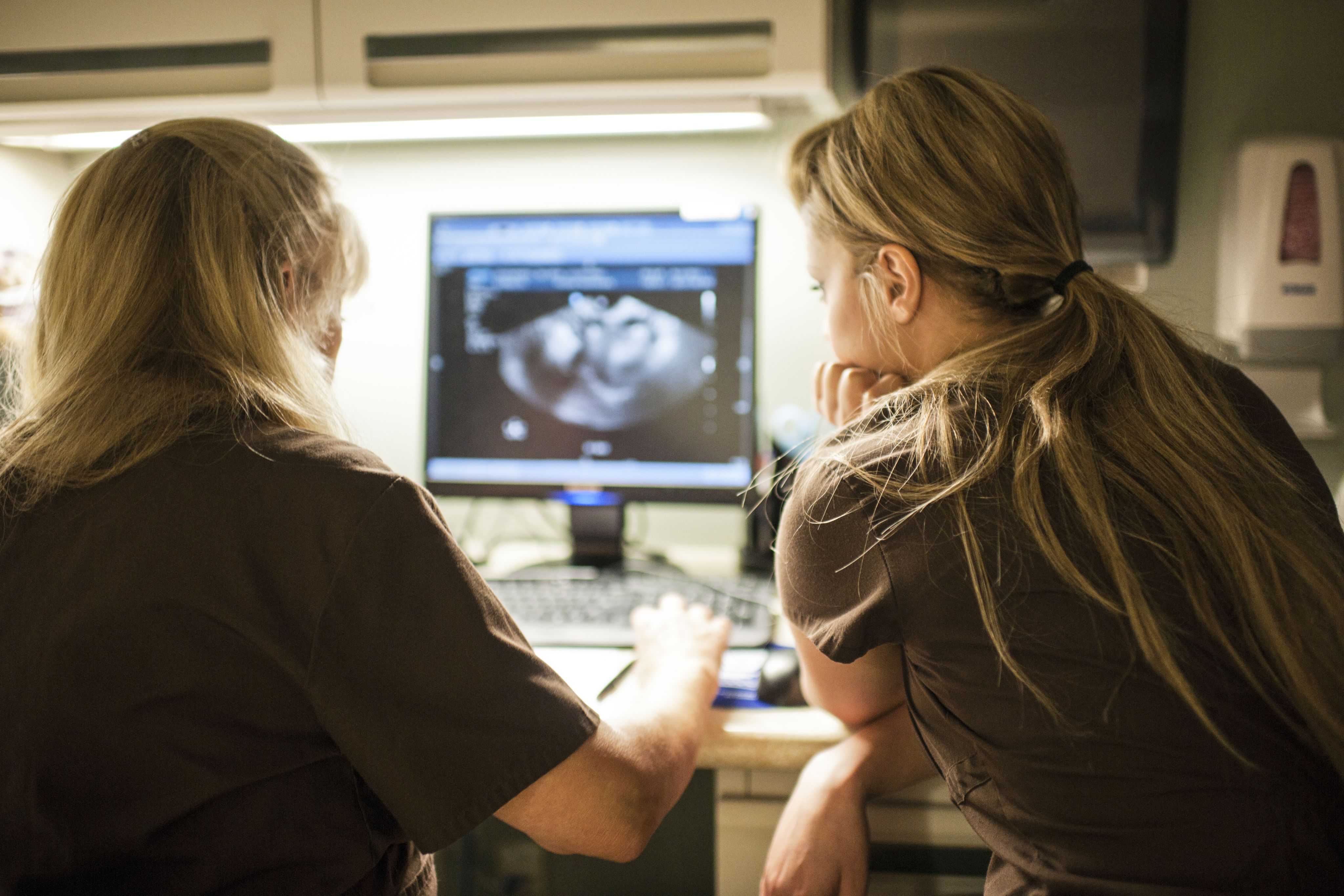The future of sonography –
an opinion

Anyone working in a UK healthcare environment is likely to have a fairly clear idea of what a sonographer does; most members of the public will have seen souvenir images announcing the latest pregnancy on social media amongst friends and family; many will have experienced the anxiety of the darkened room and the cold jelly. And yet, sonography as a profession still has a somewhat blurred and uncertain identity, even amongst healthcare professionals (1). Not only is there public confusion about the role, in the United Kingdom ‘sonographer’ is still not a protected title (2). If I had been asked 30 years ago what I thought about the future of sonography I would not have predicted that in 2024 statutory regulation would still be well and truly on the back burner. In essence, anyone with access to an ultrasound system can still badge themselves as a sonographer.
Where there is clear agreement is in the recognition that sonographers are somewhat thin on the ground. The UK is experiencing a significant and sustained shortage of sonographers that has challenged the collective efforts of workforce development teams and continues to place clinical services under considerable pressure.
Anyone working in a UK healthcare environment is likely to have a fairly clear idea of what a sonographer does; most members of the public will have seen souvenir images announcing the latest pregnancy on social media amongst friends and family; many will have experienced the anxiety of the darkened room and the cold jelly. And yet, sonography as a profession still has a somewhat blurred and uncertain identity, even amongst healthcare professionals (1). Not only is there public confusion about the role, in the United Kingdom ‘sonographer’ is still not a protected title (2). If I had been asked 30 years ago what I thought about the future of sonography I would not have predicted that in 2024 statutory regulation would still be well and truly on the back burner. In essence, anyone with access to an ultrasound system can still badge themselves as a sonographer.
Where there is clear agreement is in the recognition that sonographers are somewhat thin on the ground. The UK is experiencing a significant and sustained shortage of sonographers that has challenged the collective efforts of workforce development teams and continues to place clinical services under considerable pressure.
Recent NHS England data indicate that there are an estimated 1,945 full time equivalent in-post sonographers, with an average vacancy rate of 14.9%. Demographic data suggest that this will worsen with 29% of the current workforce near or beyond normal retirement age (3). Over 10 million ultrasound tests were performed in England in the year ending April 2023 and yet National Imaging Data Collection for the same period identifies non-obstetric ultrasound as the worst performing diagnostic test with the highest number of patients waiting for more than two or more weeks (3). Given the unrelenting increase in demand for ultrasound (4), the growing complexity of healthcare services, and the unrelenting focus on targets, it is clear that something needs to change. The problem is, we have been saying this for well over a decade. Any attempt to predict the future of sonography probably needs to start with the acceptance that where we are now is not sustainable.
Recent NHS England data indicate that there are an estimated 1,945 full time equivalent in-post sonographers, with an average vacancy rate of 14.9%. Demographic data suggest that this will worsen with 29% of the current workforce near or beyond normal retirement age (3). Over 10 million ultrasound tests were performed in England in the year ending April 2023 and yet National Imaging Data Collection for the same period identifies non-obstetric ultrasound as the worst performing diagnostic test with the highest number of patients waiting for more than two or more weeks (3). Given the unrelenting increase in demand for ultrasound (4), the growing complexity of healthcare services, and the unrelenting focus on targets, it is clear that something needs to change. The problem is, we have been saying this for well over a decade. Any attempt to predict the future of sonography probably needs to start with the acceptance that where we are now is not sustainable.
Continuing challenges

Sonography as a profession and the services we deliver are affected by a host of factors that are largely out of our control. It does not take a crystal ball to predict that the current challenges faced within the NHS are likely to continue as they are exacerbated by the increasing demands of an ageing population (4). This article provides a personal reflection on how these seemingly intractable workforce shortages are being addressed and how this might affect the future of our profession.
The concept of the ‘career sonographer’ is well accepted in the UK (5) and the role is clearly documented (6).
While regulation of sonography as a distinct profession remains tantalisingly out of reach, the role of what we perceive as a sonographer has evolved significantly over the last 20 years (7). The range and complexity of examinations undertaken, and the varied contexts in which these are performed, reflect a rapidly changing healthcare landscape and unrelenting demand for diagnostics.
One of the distinct barriers to establishing sonographer professional identity has been the historic lack of a definitive career structure. However, over the last decade, the drive to address critical workforce shortages prompted significant work around the development of a career framework. In 2015, Health Education England established a working party which subsequently merged with the Integrated Imaging Workforce Working Group (IIWWG) in 2017. This group had been tasked primarily with exploring alternative models of sonographer training that would expand the potential number of recruits, without placing further pressure on existing shortage professions. The outcome of this work was support for the development of independent direct entry routes at both undergraduate and postgraduate level, and an undergraduate apprenticeship scheme (5). The emergence of these alternative pathways into the profession highlighted the need to define the scope of practice that could be expected for an entry level role, particularly for those completing a BSc.

Earlier attempts to define the role of a practitioner level sonographer had concluded that Agenda for Change “Band 6 Practitioners undertaking ultrasound are a possibility in individual clinical specialisms” if supported by robust clinical governance (7). However, there remained considerable debate (8). Subsequent development of a Career Progression Framework in 2019 (9) identified agreed capabilities that reflect the scope and complexity of the sonographer’s role. This provides a helpful indication of how the role might progress from entry level to expert and consultant level practice. However, since publication of the Career Framework in 2019, the extent to which this has been embraced to reflect role descriptions, banding and pay grades within clinical practice remains unclear.
Increasingly, service delivery is shaped to meet the requirements of defined patient pathways. This provides opportunities for development of specialist clinical roles that require more advanced capabilities including onward referral and sonographer-led discharge. It is self-evident that the capabilities we might expect of an entry level sonographer will be different. Development of a preceptorship and capability development framework (10) should enable newly qualified sonographers and managers to plan appropriate support to enable them to transition through the career framework from newly qualified to consultant.
Thinking differently about trainees

In parallel to the work undertaken by IIWWG, several UK-based Higher Education Institutions (HEIs) have developed direct entry pathways that recruit to both undergraduate and postgraduate programmes. These evolved through wide stakeholder consultation and with the express aim of meeting workforce needs. However, as predicted (11), lack of statutory regulation for direct entrants, and continuing uncertainty about the scope of entry level roles has hampered recruitment to these programmes.
While university-based education provision has adapted, approaches to training in the clinical setting have been largely unchanged over several decades. Interventions to address this are hampered by severe pressures on clinical services that were exacerbated by Covid-19. Training capacity is also challenged by a multitude of healthcare professionals across specialties who wish to develop ultrasound skills. The breadth and complexity of training requirements across the current and emerging diagnostic landscape is challenging and there is a risk that training numbers may fall.
To support training at scale, it makes sense that we need to think differently about how trainees learn. The career framework rightly focuses on development of capabilities that may be difficult to support outside of a patient focused setting. However, there is no compelling reason why all early-stage ultrasound skills development cannot be moved out of the clinical department. If we remain reliant on releasing existing staff for training, this also needs to be achievable within a short timescale to minimise service disruption. Extensive use of ultrasound simulation systems enables universities to ensure that students are confident in basic scanning skills prior to placement. However, traditional route students who are released to study part time may be disadvantaged as their time on campus is limited.
In 2022, at the University of Derby we piloted a high intensity campus-based training programme on early skills development (12). Using an active learning approach, SHIFT (Sonography High Intensity Foundation Training) combined core theory with highly structured practical sessions and computer-based simulation activities that aimed to enable trainees to develop the hand-eye coordination required for ultrasound image capture, to build familiarity and understanding of equipment controls and recognition of normal ultrasound appearances. Funding to enable part time trainees to be released to undertake similar high intensity preparatory learning, potentially via established training academies, would take further pressure off clinical departments.

Funding is also a major consideration for individual students enrolling to full time direct entry programmes. This is particularly problematic for graduate entrants who may carry heavy existing student debt and are faced with tuition fees that may exceed £10,000 per year. There is evidence emerging that this has impacted on student retention and attrition for direct entry programmes (11). At a time when NHS services are struggling to recruit and the imperative to train more sonographers is pressing, lack of credible central funding is difficult to justify. One of the proposed solutions has been the development of an apprenticeship route for sonography. This uses a funding model that enables NHS trusts to draw down funds to cover training costs for staff who are salaried throughout their training period. An undergraduate apprenticeship standard was approved for delivery in 2019 (13). The aim of this was to widen the recruitment pool to draw academic level 3 applicants into the profession in preparation for an entry level practitioner role. Development of a level 7 postgraduate apprenticeship route would enable high quality science and health related graduates to enter the profession without the burden of excessive debt.
As an educator with over 30 years’ experience of sonographer education, I am still surprised by the level of uncertainty amongst sonography colleagues about the recruitment of trainees from outside of the standard feeder professions of radiography, midwifery etc. We find no conceptual difficulty with direct recruitment into medicine and other allied health and nursing undergraduate programmes. For direct graduate entrants who hold an existing science or health related degree, the argument is even more spurious. The University of Derby offers one of only two UK-based full time MSc programmes. Recruitment to the programme is values based and open to a wide range of graduates. I am asked frequently how these individuals are prepared for clinical practice in the absence of previous clinical experience. As for any other trainee entering a role within healthcare, this is through extensive supported learning, reflection and individual capability development. However, what is frequently missed is the question of the wealth of existing skills that these individuals bring to the sonography role. Previous trainees have joined the programme with widely varying first degree qualifications including psychology, biomedical sciences, biochemistry, genetics, applied anatomy, biology, pharmacy, sport and exercise. The transferable graduate skills, underpinning knowledge, leadership skills and life experience of these individuals bring a wealth of potential as they transition into a patient facing role.
Burning out

One of the more insidious challenges faced within sonography is occupational burnout within the existing workforce. Not only does this impact on clinical service delivery, the capacity for experienced staff to support training and newly qualified staff through preceptorship may also be eroded. There is mounting evidence of the sustained impact of Covid-19 on staff wellbeing, particularly in obstetrics, with sonographers reporting high levels of lasting moral injury (14) (15). These reported experiences also highlighted a “perception of ineffective leadership and management, and a perceived lack of understanding of the complexity of the sonographer role”. Even without the impact of the pandemic, working within an area with sustained understaffing has a detrimental effect on wellbeing with increasing levels of psychological stress among both managers and frontline healthcare practitioners, physiological deterioration and injury (16).
The future of sonography will be shaped at least in part by the capacity (and willingness) of the existing workforce, to embrace change, push for effective deployment of our skills and commit to using our experience to train the next generation of sonographers. We are a shortage profession with diminishing numbers, and we cannot fix the current workforce crisis. This will require leadership decisions that ensure staff resources are directed towards evidenced patient pathways and away from poorly justified ‘screening’ investigations. Support for staff at all levels would help and it is encouraging to see emerging interest in professional supervision of sonographers (17).

The scale of workforce shortages in sonography has been highlighted recently by the almost impossible task of staffing Community Diagnostic Centres (CDCs), which were all due to be operational by March 2024 (18). International recruitment is seen by government as a key part of the response to this challenge. This is complicated by wide global variance in the role of a practising sonographer (1). In the UK the expectation is that image acquisition and reporting of an ultrasound examination are interdependent and should not be separated (19). However, independent reporting skills are not always taught or assessed outside of UK based training programmes. International recruitment provides a welcome and important part of the response to the current workforce shortage. However, there is very little guidance available for managers to recruit from overseas and a dismal lack of support for international applicants wishing to work in the UK.
Responsibility for competence

As ultrasound is not a registered profession in the UK, the Consortium for Accreditation of Sonographic Education (CASE) plays an important role in sonographer workforce development by ensuring parity between UK accredited ultrasound awards. While CASE does not accredit individuals, possession of a CASE-accredited award (or equivalent) is used frequently as a benchmark for employers when assessing applicants to work in the UK. CASE agreed learning outcomes are clearly defined (20). However, there is no established process for the assessment of equivalence. The ultimate responsibility for assessing the equivalence of an award held by any employee, and ensuring that the knowledge, skills, and competence of sonographers are appropriate for UK practice, resides with the employer. This applies to any sonographer with or without a CASE-accredited award and regardless of the country of qualification.
Provision of resources to support clinical staff and education providers to offer consistency in mapping to UK standards needs to be prioritised, along with structured support for individuals to evidence their existing competences and identify learning gaps.
As government pushes ahead to open CDCs ahead of schedule, outsourcing of service provision to non-NHS providers is perhaps inevitable. Providing the best possible service to patients is understandably the priority. However, the impact of outsourcing on training capacity for sonography may be crucial. By moving the more routine, ambulatory patients to CDCs, hospital teams will be able to focus on more complex investigations. CDCs could provide a golden opportunity to expand training capacity, with dedicated training lists and slightly longer appointment times. However, if services are outsourced, for independent providers this is unlikely to be viewed as an attractive business model. Strong local leadership will be needed to avoid further erosion of training capacity.
The future of sonography is in many ways uncertain. What is clear is that, as a profession we need to make some tough decisions on how (and if) we are prepared to adapt. My gut feeling is that statutory regulation will stay on the back burner for the foreseeable future. For now, my hope is that we will support development of staff across the full breadth of roles that the Career Development Framework defines, that we will keep an open mind about who we recruit, and that we will continue to push for sustainable funding for all training pathways. Beyond that, I will let you know when I have polished up my crystal ball.
References
1. Miles, N., Cowling, C. and Lawson, C. The role of the sonographer - An investigation into the scope of practice for the sonographer internationally; Radiography 2022 Feb;28(1):39-47.
2. Professional Standards Authority, (2019) Right-touch assurance assessment for sonographers. https://www.professionalstandards.org.uk/docs/default-source/ publications/policy-advice/right-touch-assurance-for-sonographers-a-report-for-hee. pdf?sfvrsn=9cfd7420_13 accessed 01.11.2019.
3. NHSE Non-Obstetric Ultrasound (NOUS) National Deep Dive; National Imaging Transformation Programme meeting presentation; November 2022.
4. NHSE National Imaging Data Collection 2021/22 https://www.england.nhs.uk/statistics/statistical-work-areas/diagnostic-imaging-dataset/diagnostic-imaging-dataset-2021-22-data/ Accessed January 2024.
5. Parker, P. The Career Sonographer – Myth or Reality?; Imaging and Oncology (2020) pp.40-45.
6. Society of Radiographers and British Medical Ultrasound Society Guidelines for professional ultrasound practice Eighth edition December 2023 https://www.bmus.org/media/resources/files/_2023_SoR_and_BMUS_guidelines_8th_Ed_FINAL.pdf ; Accessed January 2024.
7. Parker P, Wolstenhulme S, (2012) A workforce review in diagnostic ultrasound. Ultrasound. 20(3):165-170.
8. Parker P, Harrison G., Educating the future sonographic workforce: membership survey report from the British medical ultrasound society. Ultrasound 1:11. (2015).
9. Health Education England (HEE) (2019) https://www.hee.nhs.uk/sites/default/files/documents/Sonographer%20Career%20Framework%20-%20V2%20June%202022.pdf Accessed January 2024.
10. British medical ultrasound society; Preceptorship and capability development framework 2022; https://www.bmus.org/media/resources/files/PC_with_CPF_app_A_and_explanatory_notes_FINAL_Mar2023.pdf Accesses January 2024.
11. Society and College of Radiographers; Direct Entry Undergraduate Ultrasound Programmes (with competency to practise): a briefing Society and College of Radiographers (2013) https://www.sor.org/getmedia/d1b12950-92f5-4f76-9bd8-006d46f90dd2/Direct%20Entry%20Undergraduate%20Ultrasound%20Programmes%20(with%20competency%20to%20practise)_%20a%20briefing%20from%20the%20_1 Accessed January 2024.
12. Venables H, Coleman G, White R, Mayes JP, Hyde E; Evaluation of a sonography high intensity foundation training programme. [Paper] UK Imaging & Oncology congress. Liverpool, UK, 6th June 2023.
13. https://www.instituteforapprenticeships.org/apprenticeship-standards/sonographer-integrated-degree-v1-1 Accessed January 2024.
14. Skelton E; Smith A; Harrison G; Rutherford M; Ayers S; Malamateniou C; Sonographers' experiences during the COVID-19 pandemic; Radiography (2023) May; Vol. 29 (3), pp. 582-589.
15. Skelton E; Smith A; Harrison G; Rutherford M; Ayers S; Malamateniou C; "It has been the most difficult time in my career": A qualitative exploration of UK obstetric sonographers' experiences; during the COVID-19 pandemic; Radiography (2023) May; Vol. 29 (3), pp. 582-589.
16. Miller, P.K., Waring, L., Bolton, G.C., Sloane, C, Personnel flux and workplace anxiety: Personal and interpersonal consequences of understaffing in UK ultrasound departments; Radiography 25 (2019) 46-50.
17. Coleman, G, Hyde, E. and Strudwick, R.; Exploring UK sonographers’ views on the use of professional supervision in clinical practice - Stage one findings of a mixed method study; Radiography (2024) Vol 30. Pp. 252-256.
18. Richards, M. Diagnostics: Recovery and Renewal – Report of the Independent Review of Diagnostic Services for NHS England; NHS England (2020).
19. British Medical Ultrasound Society - Reporting of Ultrasound Imaging - Position Statement (2017) https://www.bmus.org/static/uploads/resources/Reporting_of_Ultrasound_Imaging_Statement.pdf
20. Standards for Sonographic Education http://www.case-uk.org/standards/ Accessed January 2024.

